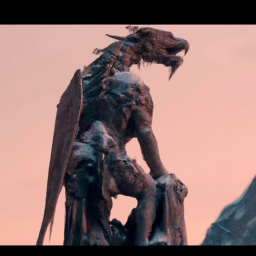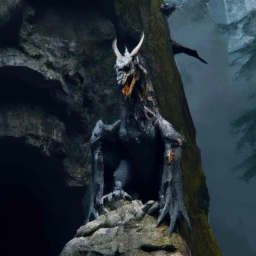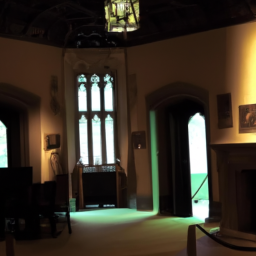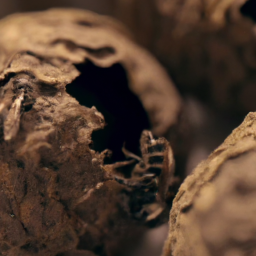Unveiling Pazuzu: Unraveling the Ancient Mesopotamian Exorcist Demon
Introduction
Pazuzu, the mischievous exorcist demon, holds a significant place in ancient Mesopotamian mythology. This enigmatic entity has left behind a rich and intriguing legacy that continues to captivate scholars and enthusiasts alike. From its distinctive appearance to its role in protecting against evil spirits, Pazuzu’s presence in ancient Mesopotamian culture offers a fascinating glimpse into the beliefs and practices of this ancient civilization. In this article, we will delve into the mysterious world of Pazuzu, exploring its origins, characteristics, and enduring influence in ancient Mesopotamian mythology.
The Origins and Mythological Significance of Pazuzu in Ancient Mesopotamian Culture
Unveiling the Enigmatic Legacy of Pazuzu: The Mischievous Exorcist Demon from Ancient Mesopotamian Mythology
The ancient Mesopotamian culture is rich with fascinating mythological figures, each with their own unique stories and significance. Among these figures, Pazuzu stands out as one of the most enigmatic and intriguing. Known as the mischievous exorcist demon, Pazuzu has left a lasting legacy that continues to captivate scholars and enthusiasts alike. In this article, we will delve into the origins and mythological significance of Pazuzu in ancient Mesopotamian culture.
Pazuzu’s origins can be traced back to ancient Mesopotamia, a region that encompassed modern-day Iraq, Syria, and parts of Iran and Turkey. He was believed to be a demon of the wind, associated with storms, droughts, and other natural disasters. Pazuzu was often depicted as a fearsome creature with the body of a man, the head of a lion or dog, and the wings of an eagle. His appearance was meant to strike fear into the hearts of those who encountered him.
Despite his terrifying appearance, Pazuzu played a crucial role in ancient Mesopotamian culture. He was believed to possess the power to ward off evil spirits and protect against demonic possession. As such, Pazuzu was often invoked during exorcism rituals and was considered a powerful ally in the battle against malevolent forces. His image was commonly used as a talisman, with amulets and statues of Pazuzu being worn or displayed in homes to provide protection.
Pazuzu’s significance extended beyond his role as an exorcist demon. He was also associated with fertility and abundance, as well as the protection of pregnant women and infants. This dual nature of Pazuzu, as both a fearsome demon and a benevolent protector, highlights the complexity of ancient Mesopotamian mythology. It is a reminder that even the most seemingly malevolent beings can have a positive side.
The mythological significance of Pazuzu can be further understood through his connections to other deities in the Mesopotamian pantheon. He was often depicted alongside the goddess Lamashtu, who was believed to be a demoness associated with infanticide and miscarriages. Together, Pazuzu and Lamashtu formed a contrasting pair, representing the duality of life and death, creation and destruction. This juxtaposition of forces was a common theme in ancient Mesopotamian mythology, reflecting the cyclical nature of existence.
Pazuzu’s legacy endured long after the decline of ancient Mesopotamian civilization. His image and symbolism found their way into other cultures and religions, such as ancient Egypt and even modern-day popular culture. In the 1973 horror film “The Exorcist,” Pazuzu was portrayed as the main antagonist, further cementing his status as a powerful and malevolent force.
In conclusion, Pazuzu, the mischievous exorcist demon from ancient Mesopotamian mythology, holds a significant place in the cultural and mythological landscape of the region. His dual nature as both a fearsome demon and a benevolent protector reflects the complexity of ancient Mesopotamian beliefs. Pazuzu’s image and symbolism continue to captivate and intrigue, leaving a lasting legacy that transcends time and borders.
Pazuzu’s Role as a Protective Demon and His Influence on Ancient Mesopotamian Beliefs

Unveiling the Enigmatic Legacy of Pazuzu: The Mischievous Exorcist Demon from Ancient Mesopotamian Mythology
Pazuzu, the enigmatic exorcist demon from ancient Mesopotamian mythology, continues to captivate scholars and enthusiasts alike with his intriguing role as a protective deity and his profound influence on the beliefs of the ancient Mesopotamians.
In the pantheon of Mesopotamian gods and demons, Pazuzu stands out as a unique figure. Depicted as a fearsome creature with the body of a man, the head of a lion or dog, and the wings of an eagle, Pazuzu was believed to possess immense power over evil spirits and demons. Despite his terrifying appearance, Pazuzu was not an embodiment of evil himself, but rather a force that protected humans from malevolent supernatural entities.
Pazuzu’s role as a protective demon was particularly significant during the ancient Mesopotamian period. The people of this region believed in the existence of various malevolent spirits that could bring harm and misfortune upon them. Pazuzu, with his ability to ward off these evil forces, became a symbol of hope and security for the Mesopotamians.
The influence of Pazuzu extended beyond his role as a protector. He also played a crucial part in shaping the beliefs and practices of the ancient Mesopotamians. The presence of Pazuzu can be seen in various aspects of their culture, from religious rituals to everyday objects.
One of the most notable examples of Pazuzu’s influence is the use of amulets. These small, often intricately carved objects were believed to possess magical properties that could ward off evil spirits. Many amulets from ancient Mesopotamia feature the image of Pazuzu, emphasizing his role as a protective deity. These amulets were worn by individuals as a form of personal protection, and they were also placed in homes and temples to safeguard against malevolent forces.
Pazuzu’s influence can also be seen in the art and iconography of ancient Mesopotamia. His distinctive appearance is frequently depicted in sculptures, reliefs, and other artistic representations. These depictions not only served as a visual representation of Pazuzu but also reinforced his role as a protective deity. The presence of Pazuzu in art was a constant reminder of his power and the need for protection against evil forces.
Furthermore, Pazuzu’s influence extended to religious rituals and ceremonies. In exorcism rituals, priests would invoke Pazuzu’s name and image to drive out evil spirits from individuals who were believed to be possessed. The belief in Pazuzu’s ability to expel demons was so strong that his name and image became synonymous with exorcism itself.
The legacy of Pazuzu continues to intrigue scholars and researchers, as his influence can be traced to other cultures and time periods. The image of Pazuzu, for example, was famously featured in William Peter Blatty’s novel “The Exorcist” and its subsequent film adaptation. This portrayal of Pazuzu as a malevolent entity, however, deviates from the ancient Mesopotamian belief in his protective nature.
In conclusion, Pazuzu’s role as a protective demon and his profound influence on ancient Mesopotamian beliefs make him a fascinating figure in mythology. From his ability to ward off evil spirits to his presence in art and religious rituals, Pazuzu’s legacy continues to captivate and inspire. As we delve deeper into the enigmatic world of ancient Mesopotamian mythology, Pazuzu remains a symbol of protection and a testament to the enduring power of belief.
Unraveling the Symbolism and Iconography of Pazuzu: A Closer Look at Ancient Artifacts and Depictions
Unveiling the Enigmatic Legacy of Pazuzu: The Mischievous Exorcist Demon from Ancient Mesopotamian Mythology
Pazuzu, the enigmatic exorcist demon from ancient Mesopotamian mythology, has long fascinated scholars and enthusiasts alike. Known for his mischievous nature and unique role in ancient beliefs, Pazuzu’s legacy can be unraveled through a closer examination of the symbolism and iconography found in ancient artifacts and depictions.
One of the most prominent symbols associated with Pazuzu is the scorpion. In ancient Mesopotamia, scorpions were believed to possess protective qualities, capable of warding off evil spirits. Pazuzu, with his scorpion-like features, was often depicted with a scorpion tail and claws, emphasizing his role as a guardian against malevolent forces. This symbolism is evident in various ancient artifacts, such as amulets and statues, where Pazuzu is shown with a scorpion tail poised to strike.
Another significant aspect of Pazuzu’s iconography is his distinctive facial features. Pazuzu is often depicted with a grotesque, bird-like face, complete with bulging eyes, a hooked beak, and wild, unruly hair. These features are believed to represent his chaotic and unpredictable nature, as well as his ability to instill fear in those who encounter him. The exaggerated facial expressions found in ancient depictions of Pazuzu serve as a visual reminder of his power and influence.
Furthermore, Pazuzu is frequently depicted with wings, a characteristic that sets him apart from other Mesopotamian deities. These wings symbolize his ability to traverse between the earthly realm and the spiritual realm, making him a powerful intermediary between humans and the divine. The wings also represent Pazuzu’s association with the wind, as he was believed to control the winds and bring forth storms. This connection to the natural elements further solidifies Pazuzu’s role as a force to be reckoned with.
In addition to his physical attributes, Pazuzu’s iconography often includes various objects and animals that further enhance his symbolism. One such object is the snake, which is frequently depicted coiled around Pazuzu’s body or held in his hands. The snake represents Pazuzu’s ability to manipulate and control the forces of chaos, as well as his association with fertility and rebirth. Another common element found in Pazuzu’s iconography is the lion, a symbol of strength and power. The lion is often depicted alongside Pazuzu, emphasizing his role as a protector and guardian.
The significance of Pazuzu’s iconography extends beyond mere symbolism. Ancient Mesopotamians believed that by wearing or possessing objects adorned with Pazuzu’s image, they could invoke his protective powers and ward off evil spirits. Amulets featuring Pazuzu were commonly worn by individuals seeking protection from malevolent forces, and statues of Pazuzu were often placed in homes and temples to ensure the safety and well-being of the inhabitants.
In conclusion, the symbolism and iconography associated with Pazuzu provide valuable insights into his enigmatic legacy as the mischievous exorcist demon from ancient Mesopotamian mythology. Through the examination of ancient artifacts and depictions, we can unravel the multifaceted nature of Pazuzu’s character and understand his significance in ancient beliefs. From his scorpion-like features to his distinctive facial expressions and wings, Pazuzu’s iconography serves as a visual representation of his role as a guardian and intermediary between humans and the divine. The objects and animals depicted alongside Pazuzu further enhance his symbolism and highlight his association with protection and power. By delving into the world of Pazuzu’s iconography, we gain a deeper understanding of the ancient Mesopotamian beliefs and the enduring legacy of this captivating exorcist demon.
Q&A
1. Who is Pazuzu?
Pazuzu is a demon from ancient Mesopotamian mythology known as the mischievous exorcist demon.
2. What is the legacy of Pazuzu?
The legacy of Pazuzu lies in his representation as a powerful and malevolent demon associated with chaos, disease, and possession in ancient Mesopotamian culture.
3. How is Pazuzu depicted in ancient Mesopotamian art?
Pazuzu is often depicted as a fearsome creature with a combination of human and animal features, including a lion or dog-like head, wings, and a scaly body. He is often shown with his mouth open, symbolizing his ability to expel evil spirits.
Conclusion
In conclusion, the legacy of Pazuzu, the mischievous exorcist demon from ancient Mesopotamian mythology, remains enigmatic. Despite being associated with malevolent acts, Pazuzu also served as a protective deity against evil spirits. The complex nature of Pazuzu’s character and his role in ancient Mesopotamian culture continue to intrigue scholars and researchers, shedding light on the rich mythological traditions of the region.



